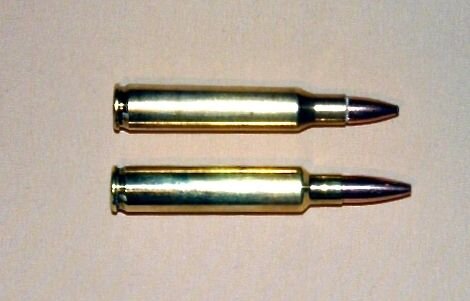222 Remington Magnum
The 222 Remington Magnum is one of the smaller cartridges to have an Ackley Improved version. A factory load is shown along with a match-loaded Ackley version, slightly fire-formed to nearly straight and with a 40-degree shoulder.
The 222 Remington Magnum is a much better cartridge for bolt action rifles than the 223 Remington. The 223 was essentially a development of the 222 Rem Mag that would function more reliably in full- and semi-automatic military rifles. The longer neck of the 222 Rem Mag was a bit of a hangup, but for the accuracy buff it is an advantage. Unfortunately, hardly anyone makes a rifle chambered for the 222 Remington Magnum anymore. Cooper Firearms of Montana can build you a rifle so pretty that you'll be reluctant to take it to the field. Brass supplies are getting intermittent for the 222 Mag. Get orders in and wait patiently. Don't be shy about buying 500 or more pieces at a time, because barrel life is astoundingly good. Also, brass lasts a long time, especially when just neck sizing. The cartridge produces amazing accuracy, and it's easy to develop a good load. The best performance I ever had in a bench rest match was with the 222 Mag (which is what I prefer to call it for brevity), loaded with home-made bullets weighing an average of 51 grains, using
IMR 4895 Powder and Remington 7 1/2 Primers. The aggregate for five 5-shot groups was 0.086 of an inch. Said differently, right at 1/12th of an inch.
Most of today's bench resters have moved to various 6mm cartridges, especially the 6mm PPC and the 6mm BR. The 6mms handle outdoor conditions a little better than the 22s, especially at 200 and 300 yards. The 22 PPC and the 22 BR started to move the 222 Mag out of contention even before the 6mms took over, but I'm not sure why. My 222 Mag bench gun shot with or better than the best of them. I was very fussy about bullets and cases. Had a special die set made up, and only took about 15 pieces of brass to a match. The brass for the 22 PPC had a head start, as all of the stuff being made was of high quality. The 222 Mag brass was regular factory production being spanked out at high speed, so you really had to be particular (or is it peculiar?) to get maybe 20 good pieces to start with out of a hundred inspected.
The 222 Mag came from the 222 Remington, which came from the fertile mind of Mike Walker. When Walker, of Remington, was asked to hop up the 222 to make a small round that would perform certain military requirements, he came up with the cartridge we're talking about, but at that time it was being referred to as the 224 Springfield. It didn't make the grade, and some of history blames that mostly on the design of the rifle it was being tested in. Whatever. The good part is that when the military dropped it, Remington picked it up as a commercial cartridge and introduced it as the 222 Remington Magnum in 1958. At the time, more than a few 222 owners had the Magnum reamer run into their chamber so they could switch to the new cartridge.
After having nearly a dozen 222 Mags over a period of at least 50 years, I can tell you that mine always have preferred flat-based bullets weighing 50 to 53 grains. All of them have had a 14-inch twist. Cooper uses a 12-twist barrel, so perhaps 55-grain bullets, and even boat tails, will work the best in them. Without testing, I sure can't say so with any authority. I currently have two rifles in 222 Mag, a yet unfired (except for the tiny groups the Custom Shop sent with it) 40-XB Rangemaster with upscale wood and a Badger bushing, and an Ed Brown Compact Varmint; both single shot bolt actions. Powder choices can be many, but good old IMR 3031 works quite well for me with bullets weighing up to 50 grains. Sometimes when using 50-grain bullets, and always when using 51- to 55-grain bullets, I use IMR 4895. Consult loading books when developing your own load for your own rifle.
I find the 222 Remington Magnum to be as accurate and less fussy than the 222 Remington. When a 222 Remington is shooting at its best, look out! It can beat just about anything. The problem I've had is that they don't always shoot the same when the weather conditions change from day to day. And, there is no powder that seems to be exactly ideal for them. IMR 4198 can be fine one time, and have you biting your tongue the next trip to the range. The same is true for H322, although it may be a little more consistent. If there isn't much of a breeze, and you can get by with a velocity loss of about 150 fps, IMR 4895 is a good choice. None of this seems to happen with me when shooting a 222 Remington Magnum. I can load up with IMR 4895, head to the range to check it, and then head to the field to enjoy the day.
Skinny-barreled 222 Mags shoot just fine, because the barrel doesn't heat up too fast. Cooper uses a 12-inch twist, which should nicely stabilize Nosler's 64-grain Bonded Solid Base. That can turn one of Cooper's delightful little masterpieces into a walkabout varmint rifle as well as a deer and pronghorn rifle where legal, all the while being a family heirloom. Order the stock sized down a bit for the wife, and she'll be pleased with the lack of recoil. For Remington, we suggest kicking out more brass, making factory rounds available, and start chambering the 222 Remington Magnum in the 700 CDL.
JDC
